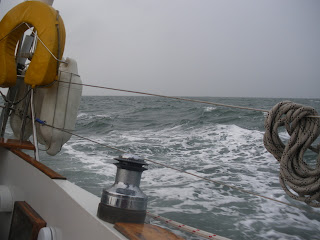Monday started badly - with another yacht noisily rafting up against SIRENA at 0430. We were due to get up at 0530 to leave an hour later so Nic warned them of this fact, and they went elsewhere.
Then at 6am, halfway through the usual engine checks, he found a big problem. A copper pipe which carries cooling seawater, had had a hole worn in it by the belt and had spewed seawater all over the engine. Nic removed the pipe. Things looked bad - could we get it replaced? No said the manufacturer. Our tight schedule to get to Newcastle to pick up Lesley's cousin was under threat. See the boatbuilders down the quay, said the Eyemouth harbourmaster. We walked down there with the offending pipe in hand, and 30 minutes later, returned with a welded and repaired pipe, at no charge. Bless the boatbuilders.
We started off for Newcastle 4 hours late and this was a long twelve hour day. No wind, blue skies, motoring as usual, past Holy Island and the Farne Islands. And then at Alnmouth, the magic began.
We saw two dolphins, and they stayed with us for a total of 5 and half hours, until we finally turned into the River Tyne. When we knelt and looked over the bow, there was one of them, hanging a foot below in crystal clear water, swimming at our pace, with every beautiful inch visible. They would stay there for 10 minutes while we watched avidly, then dive under the bow and leap up in the water, but always come back to the bow again where one of us was waiting to watch them.
The effect of seeing these wild creatures at such close quarters was electric. We both had massive smiles pasted across our faces with the sheer joy of it. And it hasn't worn off yet.
We arrived at North Shields marina at midnight and collapsed into bed. Today Lesley's cousin Dave arrived to crew for us. We're really looking forward to having him with us for some of the long legs south.









































